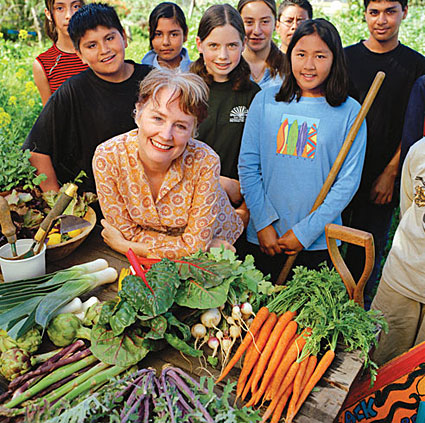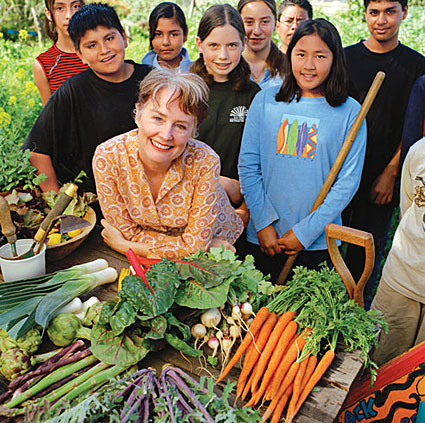 Alice Waters and MLK Jr. middle school students in the Edible Schoolyard.Photo: Edible SchoolyardSupporters of school gardens were positively giddy last week over news that a three-year UC Berkeley study of a garden and cooking initiative in Berkeley, Calif., schools had shown that it made students more eager to eat vegetables and choose healthy food.
Alice Waters and MLK Jr. middle school students in the Edible Schoolyard.Photo: Edible SchoolyardSupporters of school gardens were positively giddy last week over news that a three-year UC Berkeley study of a garden and cooking initiative in Berkeley, Calif., schools had shown that it made students more eager to eat vegetables and choose healthy food.
Berkeley restaurateur Alice Waters, through her Chez Panisse Foundation, has done pioneering work and invested considerable funds in the idea that children exposed to gardening and cooking will develop healthier eating habits. According to researchers at the university’s Dr. Robert C. and Veronica Atkins Center for Weight and Health, fourth- and fifth-graders in her “highly developed” garden and culinary program increased their consumption of vegetables by nearly one serving per day.
But a closer look at the report reveals that as students moved into middle school, they not only made little further progress, but they actually regressed — even though they spent more time in gardening and cooking classes.
The findings are sobering for the edible school garden movement, indicating as they do the extraordinary resources that had to be put into play to achieve mixed results. For thousands of educators and parents pinning great hopes for children’s health on a school garden of their own — struggling to put a garden in place with little funding or support from school administrations, struggling to keep it going with no paid staff and unreliable volunteers — the notion that success depends on having a full-time gardener (or three), a paid cooking instructor, dedicated kitchen facilities and a revamped curriculum to go with meals made from scratch in the cafeteria, has to be a bit daunting, even while it validates Waters’ years of unflagging work in the field.
Sowing the delicious revolution
Berkeley schools are in the fifth year of a major food-service overhaul instigated by parents with help from the Chez Panisse Foundation and the nonprofit Center for Ecoliteracy. The schools eliminated processed, reheated meals and adopted food made from scratch. A local bond initiative helped pay for a new central kitchen. Meanwhile, the School Lunch Initiative, designed to teach children the connection between how food is grown and prepared and their own health, installed gardens in all 11 of the district’s elementary schools and three middle schools. Thirteen instructional kitchens were built.
Waters’ vision of children growing and cooking their own food has inspired school gardens across the country. The perceived benefits have been the subject of sometimes furious debate.
The researchers reported that there was wide variation in how Berkeley schools rolled out the School Lunch Initiative. They also said it was difficult to establish a control group for their study with which to measure results.
So what they did was to divide Berkeley schools into two groups, one described as having a “highly developed” garden, cooking, and nutrition education program, and the other having a “less developed” program. We’ll call these groups HD kids and LD. They selected two elementary schools in each group and began tracking the progress of fourth- and fifth-graders using questionnaires and photographs of what the kids chose for lunch.
The two LD schools, represented by 193 fourth- and fifth-graders, had no paid garden staff, little to no garden programming, and students who spent little or no time in the garden. In addition, these two schools had no paid cooking staff and no cooking classroom, and teachers in the school had done little to integrate nutrition lessons into the curriculum. These schools tended to have larger proportions of students from higher-income families and were thus ineligible for outside funding to pay for enhanced programs.
In contrast, the two HD elementary schools, represented by 134 fourth- and fifth-graders, had paid garden and cooking staff, and the students spent 22 to 56 hours in garden and cooking classes each year. In addition, some teachers had integrated nutrition into the curriculum. These schools tended to have higher proportions of low-income students and were thus eligible for outside funding to pay for enhanced programs.
All three of the middle schools that these students eventually attended for sixth and/or seventh grade had garden and cooking programs in place, although some programs were more advanced than others. At the Edible Schoolyard run by the Chez Panisse Foundation at Martin Luther King Jr. Middle School, for instance, several people are employed to maintain and give instruction in the garden, and a kitchen is lavishly equipped with an instructor and volunteers, individual workstations with a full complement of cooking tools, four cooktops with sinks, a free-standing convection oven, and a commercial-grade dishwashing system.
Following the students from these four schools over a three-year period yielded these results:
- In Year One, both the HD and the LD fourth- and fifth-grade students all ate about the same amount of fruit and vegetable servings per day (about 4 servings, or 2 cups). In Year Two, the younger HD students (fourth graders who had moved into fifth grade) had increased their consumption of vegetables by nearly 1 serving (0.4 cups), and for both fruits and vegetables by about 1.5 servings (0.7 cups). The LD kids had decreased their consumption of both fruits and vegetables by nearly 0.4 servings.
- As they became fifth-grade students in Year Two, the HD fourth-graders showed upward trends in family dinners prepared from scratch, eating with their families nearly every day, using recipes from school at home and helping prepare dinner. In contrast, the LD fourth-graders showed no increase in these behaviors, although more students from these schools said they ate family dinner nearly every day and this remained consistent from year one to year two.
- HD kids showed significantly greater preferences for green leafy vegetables in particular as they moved into fifth grade, compared to the LD fourth-graders. But by seventh grade, preference for fruits and vegetables was similar among the various exposure groups, except for HD kids having more of a taste for green leafy vegetables.
- Sixth-grade students showed no significant increase in fruit and vegetable consumption compared to the previous year, but seventh-grade students in the HD middle school [presumably Martin Luther King Jr.] showed small increases in total fruit and vegetable consumption, putting them at a consumption level of about 4.5 servings of fruit and vegetables daily. Seventh-graders in the other middle school, where there was less exposure to School Lunch Initiative components, showed a mean decrease in both fruit and vegetable consumption of about one serving per day.
- By Year Three, HD seventh-graders had increased their nutrition knowledge scores by 5 percent over the previous year, while students attending the other two, LD middle schools, had decreased their knowledge scores by 6 percent in one school and 14 percent in the other.
- At the one middle school where seventh-grade students showed a mean decrease in fruit and vegetable consumption of about one serving per day, the cooking and garden programming was
offered only as an elective — indicating the need for continued exposure to the School Lunch Initiative into middle school.
The findings roughly confirm my own anecdotal experiences working for a week in the “Dining Commons” at Berkeley’s Martin Luther King Jr. Middle School, which I reported on for the Cafeteria Confidential series. Despite being involved in Waters’ flagship “Edible Schoolyard” gardening and cooking program, students displayed a conspicuous indifference to vegetables in the food line. The three-year evaluation seems to indicate that while pre-teens embrace the idea of eating more healthfully, they lapse into a sort of food funk as they enter puberty.
“I think in middle school, developmentally kids are all over the place. It is really a tough stage, and it’s also reflected in their food choices,” Bonnie Christenson, executive chef for Berkeley schools, said about the evaluation’s results. “In high school, you see the kids starting to eat salad again. They’re moving away from their parents’ control, but they are more mature and responsible. They eat a wider variety of foods including veggies.”
But, as Christenson notes, “The study doesn’t cover a long enough period to reflect this.”
So, do memories of gardening and cooking lessons revive in high school, or after adolescence, and produce more food-conscious adults? That was the hope of Berkeley’s food service team, who stressed to me repeatedly while I was there that kids must be exposed to healthier foods even if they don’t eat them, in the hope that the lessons will inform their eating habits later in life.
“I really do think it makes an impact for life — truly,” said chef Ann Cooper, who was hired by Waters to reform the meal program at Berkeley and now runs food service for schools in Boulder, Colo. “Middle school is tough no matter what. But in all other academic domains we continue to work with them, and we need to in this area as well.”
Waters, who was quoted celebrating the study’s results in The Washington Post and the San Francisco Chronicle, did not respond to my query about the underwhelming middle school findings.
“Middle school is often a time when eating habits worsen as children move into adolescence,” is as close to an explanation as the authors of this report offer. “To sustain gains in healthy eating made by program exposure in the younger grades,” they conclude, “continued learning and availability of healthy food options can help overcome the pull toward poor habits.”
In other words, carry on.



